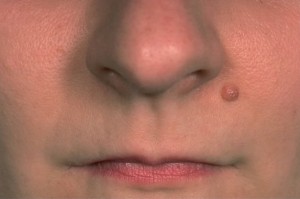Moles
 Moles are common skin lesions. In fact, most people have several and their presence is generally of no concern. The medical term for a mole is a ‘melanocytic nevus’. They are caused by a proliferation of the pigment cells (melanocytes) under the skin and are benign (harmless) in nature. The number of moles on the skin depends on genetic factors and the degree of sun exposure.
Moles are common skin lesions. In fact, most people have several and their presence is generally of no concern. The medical term for a mole is a ‘melanocytic nevus’. They are caused by a proliferation of the pigment cells (melanocytes) under the skin and are benign (harmless) in nature. The number of moles on the skin depends on genetic factors and the degree of sun exposure.
Moles may be flat or protruding and vary in colour from pink to dark brown or black.
Most are round or oval but some may be irregular in outline and they range in size from a couple of millimetres to several centimetres in diameter.
The most common reason I am asked to remove a mole is because the patient is concerned about its appearance or because it has become a nuisance, such as becoming irritated by clothing, comb or razor.
If you are considering having a mole removed, please telephone us on the appointments number or complete the contact us form. You will be asked to complete a booking form to include some details about your current medication, allergies etc. and may ask you to send photographs of your mole(s) or skin lesion in advance in order to be able to advise you over the telephone which can often save you attending for a pre-operative appointment.
You can rest assured that all information regarding your health will remain completely confidential in line with GMC guidance.
What are the different types of mole?
Benign moles are divided into those which are flesh coloured and those which are pigmented.
Flesh coloured raised moles
In medical terms, a non-pigmented, flesh-coloured raised mole is called a ‘cellular naevus’. These benign (non-cancerous) moles are very common and can be removed by either shave excision or elliptical excision depending on their size and location.
Skin coloured moles can usually be safely removed with an excellent cosmetic outcome.
If you are concerned about a flesh coloured mole and are considering having it removed, please either call us on the appointments number above or complete the contact form and tick the minor surgery check box. We will be happy to arrange an appointment or a call-back with Dr Doron Boone at your convenience.
Pigmented or Hairy Moles – Melanocytic Naevi
Pigmented moles may be flat, raised or hairy. The pigmented cells lie deep in the skin and the most effective way to remove these types of moles is by surgical excision under local anaesthetic. Moles are classified as Junctional, Dermal or Compound depending on which layer of the skin the cell nests are found.
Options for Mole Removal – surgical procedures
Shave excision
Elliptical Excision
If you are concerned about a pigmented mole and are considering having it removed, please either call us on the appointments number above or complete the contact form and tick the minor surgery check box. We will be happy to arrange an appointment or a call-back with Dr Doron Boone at your convenience.
Book a Minor Surgery Consultation
Here are some frequently asked questions about moles …...
I have a firm fibrous lump on my leg – Is this a mole?
Not necessarily – It may be Dermatofibroma)
Can moles become malignant?
The good news is that most moles are not cancerous and can be treated in our clinic with simple surgical excision.
What is a Malignant melanoma?
Malignant Melanoma
Rarely, a malignant melanoma may arise within a mole and the more moles an individual has, the greater the risk. The following features may possibly suggest malignancy:
- Unusual uneven borders or asymmetric shape
- A mole that has bled or ulcerated
- Rapid growth or colour change
- Diameter larger than 6mm.
If you are concerned about malignancy, you should contact your GP who may arrange an urgent referral to the NHS pigmented lesion clinic for a detailed assessment.
Options for Mole Removal – surgical procedures
Book a Minor Surgery Consultation

